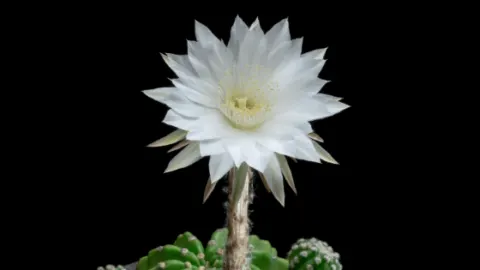Perhaps one of the more interesting plant species alive is Echinopsis subdenudata or Easter lily cactus, a plant that is part of the cacti family.
To translate the name of this plant species into a more memorable name, you can also call this the Easter lily cactus.
This cactus originates from parts of Paraguay and Bolivia where the climate ranges from humid and tropical to cold and partly dry in the cooler months of April through October.
They are found in mountainous and hillside areas as opposed to some cacti being found in deserts.
Appearance-wise, Echinopsis subdenudata is a short, stout, and bulbous plant with fuzzy-looking spines. Most of these plants barely have any spines but otherwise, they are harmless even to the most carefree plant owner.
Here comes the part where this could be one of the more interesting species alive – it grows these beautiful white flowers that can reach up to 22cm long.
These white flowers are funnel-shaped night-bloomers that flourish throughout the spring and summer.
What is unique is that these flowers open on the morning of the first day and remain open all night long.
Though fair warning, cherish the beauty of these flowers when they are blooming because they start to wilt quite fast.
As houseplants, echinopsis subdenudata makes your room feel ambient and exotic, adding a quirky spark against your decor.
Table of Contents
Echinopsis subdenudata Care Guide
Soil
When choosing soil type, Echinopsis subdenudata needs good drainage. As all cacti plant species deteriorate when their roots remain wet or moist due to improper soil drainage, the same applies to this lily cactus.
Not only should you go for well-drained soil, you should ensure that the soil is also light and gives for sufficient aeration.
You can create your own soil mixture by using potting soil and some grainy materials to give the overall soil some grit. Some materials to give the soil a grainy texture include perlite, sand, and pumice.
An ideal mix would be 40% potting soil, 40% perlite and 20% sand.
Light
Echinopsis subdenudata does well under partial to full sunlight. If you think about it, they do originate from a place that gives off strong, natural light from the sun’s rays. Therefore, try to find an ambience that can provide the same homey lighting for these plants.
Depending on the region in which you live, place these plants in the sunniest spot you can find in the summer growing months. In the winter months, still ensure that proper light is given to them.
These little pots of joy need their happy vitamins just as much as we need these plants to give us our daily dose of happiness and enchantment!
Watering
As part of the cacti family, you may think that echinopsis subdenudata would need little watering to thrive as most cacti would essentially require. However, this bulbous, dainty plant enjoys regular watering during its growing season.
During the summertime, water once a week, or once every other week. To determine this, wait until the soil is fully dry before its next watering.
During the wintertime, minimal watering is required – once a month. Echinopsis subdenudata normally stops growing in the colder months hence, very little watering is needed.
Temperature
Because echinopsis subdenudata comes from a varied climate of humid, tropical to cooler, semi-arid, you would want to mirror similar conditions as best you can at home. Nonetheless, because they can handle such varied climates, they make easy, no-fuss plants at home.
Temperatures can go as low as 50 degrees Fahrenheit (10 degrees Celsius). This cactus species can take even lower temperatures, but dependent on the fact that the soil must remain completely dry.
In the winter months, since they go into hibernation, it is best to move them into a colder spot at home. Cooler, but not freezing.
Humidity
Relatively speaking, homes are 20% to 60% humid. Because echinopsis subdenudata can withstand humid conditions, adjusting your home conditions for these plants may not be necessary.
However, stay cautious. As these plants hail from the cacti family, their thick, sturdy physique are able to store enough water to keep it persisting.
Additionally, too much moisture can cause the stems and roots to wither away. Therefore, an ideal humidity level would be at roughly 30%.
Fertilizer
During its growing season, Echinopsis subdenudata would need a bit of fertilizer to sustain.
Some people may warrant that you need more phosphorus than potassium when scouting for a fertilizer, but essentially, having equal parts of nutrients will do just fine. During the winter months, feeding isn’t necessary, unless you notice nutrient deficient-caused roots and stems.
In the growing summer months, this plant species will need feeding about every fourth to eighth week. You may use liquid fertilizer, or a standard fertilizer, to feed this cactus.
As always, use your judgment, under-feeding them would be safer than over-feeding them if you cannot tell how much is enough. Keep in mind though that when you first pot or repot this plant, it doesn’t require consumption in the first year.
For your general knowledge, fertilizers contain nutrients like nitrogen, phosphorus and potassium. When purchasing fertilizers, you may notice a three digit number ‘#-#-#.’ This shows how many pounds of nitrogen, phosphorus and potassium there are in the mix, respectively.
Propagation
To propagate echinopsis subdenudata, you can do so in two ways. Many people grow these plants in greenhouses, or in conditions that are not native to this species.
One way to propagate this kind of cactus is to use seeds and plant them in the soil mixture. Properly mix them well in the soil and place a cover over the pot to ensure moisture.
This process takes about twelve months and it would be best done from early to late spring.
Another way to propagate them is by using offsets, or stem cuttings, to plant them. The cutting made should be left to completely dry for a few days before a callous would form.
Thus, the callous can then be placed in the potted soil mixture for propagation. This way can be done from early spring to late summer. Propagation of Echinopsis subdenudata is explained further in detail below.
Growth
Echinopsis subdenudata grow perfectly well in the summer time. The cactus part can grow as big as 30cm with about eight to twelve ribs.
The white, fragrant flower that grows atop the cactus can be as tall as 22cm. Growth is consistently steady within the summer months of its growing season.
Do keep in mind that because these plant species are native to the southern Hemisphere, seasons are reversed.
The summer months in which they grow could actually be your winter months if you are located in the northern hemisphere and you hope to be a caregiver to these precious gems.
You can check out the bloom calendar of these plants here.
Potting
When potting Echinopsis subdenudata, go for pots that have holes at the bottom to ensure well-drainage and sufficient aeration.
There are plenty of options to choose from as most plants need proper water and soil drainage. Such pots can also allow water to evaporate through their porous materials. You don’t need a big pot for these cacti plant species.

How not to kill your Echinopsis subdenudata
Propagating Echinopsis subdenudata Step-by Step
To go into further detail as to how to propagate Echinopsis subdenudata, there are two ways as aforementioned above:
The first way is to use seeds and sow and evenly distribute them in their gritty soil mixture as discussed how to do so in the soil section. This method should be done in the spring time.
Once sown, mist the seeds and use a cover over them to provide and maintain moisture throughout this growing period. Try to place them under partial shade.
Remove the cover daily and wipe the condensation of the cover so that the mix isn’t wet but just moist. This process can take up to twelve months before you can pot.
The second method is through offsetting. Offsetting is a term for a part of the main plant that has maturely grown smaller parts of its own kind that can be cut to grow more of the same species.
Take the cut part and let it dry for several days. It needs to be completely dry. A callous would thus be formed. Take this callous and pot it in the well-drained soil mixture to place in a warm spot.
Doing so will allow roots to start to form. Please note that not all echinopsis subdenudata form small sections of their own from the main plant. If that is the case, then seeding would be your only option.
Common Problems with Echinopsis Subdenudata
A common problem with Echinopsis subdenudata would be the fact of keeping the conditions suitable for its growth and livelihood. These plant species can live through varying temperate climates.
Therefore, with changing seasons, you would need to monitor how much light and water is needed, as well as maintain consistent humidity levels.
Over-watering would be the biggest dilemma posed. Keep a lookout for how wet or moist the soil is before providing the next drink.
These plants are still cacti, which overall have thick skin to absorb and store enough water to live through dry periods.
Tips to Keep Echinopsis Subdenudata Problem-free
To keep Echinopsis Subdenudata problem-free, show them some love by checking up on the daily. They thrive on the best conditions through changing climates.
Check that the soil is properly drained by seeing if it dries up after each watering.
Ensure proper sunlight is given to them during the warm, summer months and that a cool spot is given to them when they hibernate in the winter months. All-in-all, stay cognizant as temperatures change.
Frequently Asked Questions About Echinopsis Subdenudata
What do I do if I over-watered my Echinopsis subdenudata?
If you over-watered your echinopsis subdenudata, let it sit until you see that the soil has dried out. If the problem persists for a few days after having it sit to dry, then you may want to consider repotting this plant.
Repotting this plant shares the same procedures as to how you would first pot it. Clean the pot you will use and add in new soil mixture to place under the proper lighting.
Do I need to prune Echinopsis subdenudata?
No, you do not need to prune this kind of plant. They make steady plants that can sustain dry periods so long as you don’t overwater them.
As for the flower that forms on this cactus, you can mist it regularly, but again, these flowers bloom at night and only for the first day. Don’t be too disappointed when you see them start to wilt quickly.
Why are echinopsis subdenudata called the ‘Easter lily cactus?’
Echinopsis subdenudata is called the “Easter lily cactus” because it is a round, egg-shaped plant in which magically sprouts a beautiful, fragrant white flower.
The way this flower blooms is quite rare as it is short-lived and opens up towards the night. It is indeed a one-of-a-kind plant among most we see in our daily lives. If you do come across one, they would surely give you a warm greeting.
Conclusion
Of all plants seen in this lifetime, Echinopsis subdenudata is perhaps one of the most unique and coolest ones to pop up. They are perfectly-sized for any home as they don’t require a big chunk of space, especially since the flowers that sprout grow vertically.
The flowers interestingly bloom at night therefore, they would make a great evening activity or source of entertainment to watch. Might I add, these cacti would also make great presents for friends and family.
If you want to add to your cactus garden or start one, Echinopsis subdenudata is one you must not miss to include. They are cute and just unique in the way they blossom and grow!


